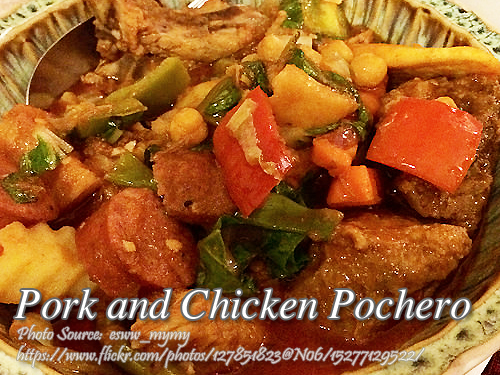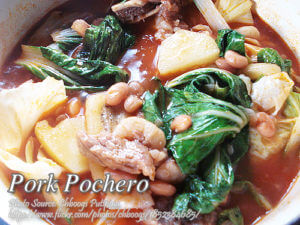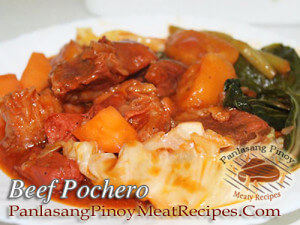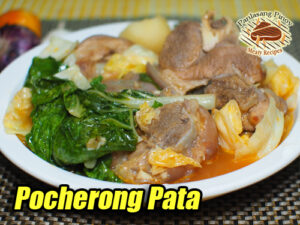Pork and chicken pochero is a tomato based stew cooked with vegetables such as sting beans, cabbage, pechay, garbanzos or chick peas, potatoes and of course, the saba bananas which makes it distinct with other Filipino tomato based dish. It is also more soupy compared to other tomato based pork stew. Pochero also has variations with regards to the meat used in cooking like beef or chicken. This pork pochero dish although pork is the main meat ingredient, it is also combined with a little bit of chicken meat. It’s up to you to omit the chicken if you want only the pork pochero.
Pork and Chicken Pochero: A Nostalgic Taste of Filipino Home Cooking
There’s something truly special about gathering around a table with family, sharing a hearty bowl of pork and chicken pochero. It’s the kind of dish that takes you back to simpler times—Sunday lunches at Lola’s house, where the kitchen smelled of garlic and onions sautéing in oil, and the comforting aroma of tomato stew filled the air.
This Filipino classic isn’t just about the ingredients or the techniques; it’s about the memories that come with every bite. My Uncle Roberto, who grew up in the lush countryside of Batangas, swears that the secret to a good pochero is the perfect balance of tender meats, rich tomato broth, and, of course, the sweet saba bananas that make this dish uniquely Filipino.
The Heart of Pochero: What Makes It Special
Pochero, derived from the Spanish word “puchero” (meaning stewpot), is a dish with deep colonial roots, adapted to fit the flavors of the Philippines. While Spanish influences gave us the idea of a tomato-based stew, the Filipino twist—adding saba bananas—makes it a dish unlike any other.
Compared to other Filipino tomato-based dishes like caldereta or afritada, pork and chicken pochero is lighter and more soupy, almost like a cross between a stew and a soup. This makes it perfect for pouring over hot steamed rice, letting the flavorful broth seep into every grain.
My sister Marites, who now lives in Cebu, often tells me how pochero reminds her of fiestas back home, where the communal pot was always brimming with fresh vegetables like cabbage, pechay, and string beans. She says the bananas are what keep it feeling authentic, a sweet contrast to the savory flavors of pork and chicken.
Cooking Pork and Chicken Pochero: Tips from My Family’s Kitchen
One of the first lessons I learned from my Tita Gloria when cooking pork and chicken pochero was the importance of tenderizing the meat properly. She would always say, “Take your time boiling the pork and chicken. A tender bite is worth the wait!” By simmering the meats with spring onions and salt, you infuse them with flavor while ensuring they’re melt-in-your-mouth soft.
Adding chorizo de Bilbao is another essential step. Its smoky, garlicky flavor gives the stew a depth that’s hard to replicate with any other ingredient. My cousin, Rey, who’s something of a pochero enthusiast, insists that stirring in chorizo right after sautéing the garlic and onions helps release its oils, blending beautifully with the broth.
Why the Techniques Work
Sautéing garlic and onion before adding the meats is a cornerstone of Filipino cooking. This process caramelizes the aromatics, enhancing their sweetness and providing a flavorful base for the stew. When you follow this with chorizo, the fat from the sausage renders out, enriching the dish with a slightly smoky and spiced undertone.
Simmering the potatoes, saba bananas, and garbanzos separately ensures they cook evenly and absorb the flavors of the broth without becoming mushy. Adding the tomato sauce after these steps allows the acidity to blend seamlessly into the stew, giving it that tangy, savory kick without overpowering the sweetness of the bananas.
The Role of Saba Bananas in Pochero
Saba bananas are what truly set pochero apart. They’re not just a filler ingredient; they add a layer of sweetness that balances the acidity of the tomato sauce and the richness of the meats. My Lola used to say that saba bananas are what make pochero feel like home—comforting, nourishing, and a little sweet, just like family life.
In some regions, cooks stir in a splash of milk at the end of cooking. This might seem unusual, but it works wonders to mellow out the acidity of the tomatoes and give the broth a silkier texture. It’s a small touch, but it elevates the dish into something that feels a little more indulgent, a little more special.
Bringing It All Together
Once the pork and chicken pochero is done simmering, serve it hot with a side of eggplant sauce—another hallmark of Filipino cuisine. The eggplant sauce, made with roasted eggplants, vinegar, and garlic, adds a tangy punch that complements the rich stew.
For me, pochero isn’t just a meal; it’s a bridge to the past. Every spoonful carries the stories of my family—Uncle Roberto in Batangas, Tita Gloria’s cooking lessons, and Marites’ fiestas in Cebu. Whether you’re cooking this dish for the first time or revisiting it after years, let its warmth remind you of home, love, and the flavors that define us as Filipinos.
So, gather your ingredients, roll up your sleeves, and give this recipe a try. It might just become your family’s new favorite—and who knows, it could be the start of a tradition you’ll pass down to the next generation.
How to Cook Pork and Chicken Pochero
Ingredients
- 3/4 kilo pork cubed
- 1/2 kilo chicken cubed
- 4 cup water
- 1 bunch spring onions
- 1 Tbsp. salt
- 1 Tbsp. cooking oil
- 4 cloves garlic crushed
- 1 pc onion chopped
- 1 pc chorizo de bilbao sliced
- 5 cup pork or chicken broth
- 4 pcs potatoes pared and quartered
- 4 pcs ripe saba or cardava bananas peeled and sliced
- 1 can garbanzos chickpeas
- 1 can tomato sauce
- 1 pc small cabbage head wedged
- 1/4 cup evaporated milk optional
Instructions
How to cook pork and chicken pochero
- In a medium saucepan, boil pork and chicken in water with spring onions and salt until tender.
- Drain meats and reserve broth. Heat oil and sauté garlic and onion until soft.
- Add the meats and chorizo de bilbao. Stir-fry. Pour the broth and bring to a boil.
- Lower heat and simmer for 20 minutes. Add the potatoes, bananas and garbanzos.
- Simmer for 15 minutes or until potatoes are tender.
- Pour tomato sauce. Add cabbage and continue simmering for a few minutes.
- If desired, stir in milk. Serve hot with eggplant sauce(search this site). Serves 8.
Notes
Cooking Tips:
Tenderize the Meats for a Perfect Texture
To ensure the pork and chicken are tender and flavorful, boil them with spring onions and salt until they’re soft but not falling apart. This slow cooking allows the flavors to penetrate the meat while keeping it moist. Avoid rushing this step, as properly tenderized meat makes all the difference in creating a comforting, melt-in-your-mouth experience.Sauté for a Flavorful Base
Sautéing garlic and onions before adding the meats enhances the depth of flavor in your pochero. The heat releases the natural sweetness of the aromatics, creating a rich base for the stew. This step may seem simple, but it builds the foundation for the dish’s robust taste, so don’t skip it!Add Vegetables in the Right Order
When adding vegetables like potatoes, saba bananas, and cabbage, timing is key to maintaining their texture. Potatoes and bananas should simmer first to absorb the broth’s flavor without becoming too soft. Add cabbage and pechay toward the end of cooking to keep them vibrant and slightly crisp, giving your pochero a delightful balance of textures.






thank you so much for featuring all kind of filipino recipes now i could cook and shared to our friends.
Hi Tess, you are welcome!
thank you for the recipes. i am learning a lot from them!
Hi Maria, I’m glad that this blog is helpful to you. Cheers!